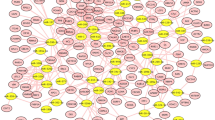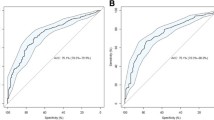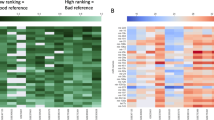Abstract
MicroRNAs (miRNAs) can regulate gene expression through binding to complementary sites in the 3′-untranslated regions of target mRNAs, which will lead to existence of correlation in expression between miRNA and mRNA. However, the miRNA–mRNA correlation patterns are complex and remain largely unclear yet. To establish the global correlation patterns in human peripheral blood mononuclear cells (PBMCs), multiple miRNA–mRNA correlation analyses and expression quantitative trait locus (eQTL) analysis were conducted in this study. We predicted and achieved 861 miRNA–mRNA pairs (65 miRNAs, 412 mRNAs) using multiple bioinformatics programs, and found global negative miRNA–mRNA correlations in PBMC from all 46 study subjects. Among the 861 pairs of correlations, 19.5% were significant (P < 0.05) and ~70% were negative. The correlation network was complex and highlighted key miRNAs/genes in PBMC. Some miRNAs, such as hsa-miR-29a, hsa-miR-148a, regulate a cluster of target genes. Some genes, e.g., TNRC6A, are regulated by multiple miRNAs. The identified genes tend to be enriched in molecular functions of DNA and RNA binding, and biological processes such as protein transport, regulation of translation and chromatin modification. The results provided a global view of the miRNA–mRNA expression correlation profile in human PBMCs, which would facilitate in-depth investigation of biological functions of key miRNAs/mRNAs and better understanding of the pathogenesis underlying PBMC-related diseases.



Similar content being viewed by others
References
Ambros V (2004) The functions of animal microRNAs. Nature 431:350–355
Bartel DP (2004) MicroRNAs: genomics, biogenesis, mechanism, and function. Cell 116:281–297
Bartel DP (2009) MicroRNAs: target recognition and regulatory functions. Cell 136:215–233
Baskerville S, Bartel DP (2005) Microarray profiling of microRNAs reveals frequent coexpression with neighboring miRNAs and host genes. RNA 11:241–247
Benjamini Y, Hochberg Y (1995) Controlling the false discovery rate: a practical and powerful approach to multiple testing. J R Stat Soc 57:289–300
Bentwich I, Avniel A, Karov Y, Aharonov R, Gilad S, Barad O, Barzilai A, Einat P, Einav U, Meiri E, Sharon E, Spector Y, Bentwich Z (2005) Identification of hundreds of conserved and nonconserved human microRNAs. Nat Genet 37:766–770
Bird A (2002) DNA methylation patterns and epigenetic memory. Genes Dev 16:6–21
Catto JW, Alcaraz A, Bjartell AS, De Vere White R, Evans CP, Fussel S, Hamdy FC, Kallioniemi O, Mengual L, Schlomm T, Visakorpi T (2011) MicroRNA in prostate, bladder, and kidney cancer: a systematic review. Eur Urol 59:671–681
da Huang W, Sherman BT, Lempicki RA (2009) Systematic and integrative analysis of large gene lists using DAVID bioinformatics resources. Nat Protoc 4:44–57
Favero F (2017) RmiR: Package to work with miRNAs and miRNA targets with R. R package version 1.22.0
Franke L, Jansen RC (2009) eQTL analysis in humans. Methods Mol Biol 573:311–328
Friedman RC, Farh KK, Burge CB, Bartel DP (2009) Most mammalian mRNAs are conserved targets of microRNAs. Genome Res 19:92–105
Gilad Y, Rifkin SA, Pritchard JK (2008) Revealing the architecture of gene regulation: the promise of eQTL studies. Trends Genet 24:408–415
Griffiths-Jones S, Grocock RJ, van Dongen S, Bateman A, Enright AJ (2006) miRBase: microRNA sequences, targets and gene nomenclature. Nucleic Acids Res 34:D140–D144
Guo Y, Xiao P, Lei S, Deng F, Xiao GG, Liu Y, Chen X, Li L, Wu S, Chen Y, Jiang H, Tan L, Xie J, Zhu X, Liang S, Deng H (2008) How is mRNA expression predictive for protein expression? A correlation study on human circulating monocytes. Acta Biochim Biophys Sin (Shanghai) 40:426–436
Guo Q, Zhang H, Zhang L, He Y, Weng S, Dong Z, Wang J, Zhang P, Nao R (2015) MicroRNA-21 regulates non-small cell lung cancer cell proliferation by affecting cell apoptosis via COX-19. Int J Clin Exp Med 8:8835–8841
Hayashita Y, Osada H, Tatematsu Y, Yamada H, Yanagisawa K, Tomida S, Yatabe Y, Kawahara K, Sekido Y, Takahashi T (2005) A polycistronic microRNA cluster, miR-17-92, is overexpressed in human lung cancers and enhances cell proliferation. Cancer Res 65:9628–9632
Huang J-T, Wang J, Srivastava V, Sen S, Liu S-M (2014) MicroRNA machinery genes as novel biomarkers for cancer. Front Oncol 4:113
Huang A, Yang Y, Chen S, Xia F, Sun D, Fang D, Xiong S, Jin L, Zhang J (2017) MiR-34a promotes DCs development and inhibits their function on T cell activation by targeting WNT1. Oncotarget 8:17191–17201
John B, Enright AJ, Aravin A, Tuschl T, Sander C, Marks DS (2004) Human MicroRNA targets. PLoS Biol 2:e363
Jones PA (2012) Functions of DNA methylation: islands, start sites, gene bodies and beyond. Nat Rev Genet 13:484–492
Krek A, Grun D, Poy MN, Wolf R, Rosenberg L, Epstein EJ, MacMenamin P, da Piedade I, Gunsalus KC, Stoffel M, Rajewsky N (2005) Combinatorial microRNA target predictions. Nat Genet 37:495–500
Lambert B, Vandeputte J, Remacle S, Bergiers I, Simonis N, Twizere JC, Vidal M, Rezsohazy R (2012) Protein interactions of the transcription factor Hoxa1. BMC Dev Biol 12:29
Laxman N, Rubin CJ, Mallmin H, Nilsson O, Pastinen T, Grundberg E, Kindmark A (2015) Global miRNA expression and correlation with mRNA levels in primary human bone cells. RNA 21:1433–1443
Lewis BP, Shih IH, Jones-Rhoades MW, Bartel DP, Burge CB (2003) Prediction of mammalian microRNA targets. Cell 115:787–798
Liu C, Wang C, Wang J, Huang H (2016) miR-1297 promotes cell proliferation by inhibiting RB1 in liver cancer. Oncol Lett 12:5177–5182
Nunez-Iglesias J, Liu CC, Morgan TE, Finch CE, Zhou XJ (2010) Joint genome-wide profiling of miRNA and mRNA expression in Alzheimer’s disease cortex reveals altered miRNA regulation. PLoS One 5:e8898
Papadopoulos GL, Reczko M, Simossis VA, Sethupathy P, Hatzigeorgiou AG (2009) The database of experimentally supported targets: a functional update of TarBase. Nucleic Acids Res 37:D155–D158
Prevoo ML, van ‘t Hof MA, Kuper HH, van Leeuwen MA, van de Putte LB, van Riel PL (1995) Modified disease activity scores that include twenty-eight-joint counts. Development and validation in a prospective longitudinal study of patients with rheumatoid arthritis. Arthritis Rheum 38:44–48
Selbach M, Schwanhausser B, Thierfelder N, Fang Z, Khanin R, Rajewsky N (2008) Widespread changes in protein synthesis induced by microRNAs. Nature 455:58–63
Shabalin AA (2012) Matrix eQTL: ultra fast eQTL analysis via large matrix operations. Bioinformatics 28:1353–1358
Shalgi R, Lieber D, Oren M, Pilpel Y (2007) Global and local architecture of the mammalian microRNA-transcription factor regulatory network. PLoS Comput Biol 3:e131
Shannon P, Markiel A, Ozier O, Baliga NS, Wang JT, Ramage D, Amin N, Schwikowski B, Ideker T (2003) Cytoscape: a software environment for integrated models of biomolecular interaction networks. Genome Res 13:2498–2504
Shi Z, Hu Z, Chen D, Huang J, Fan J, Zhou S, Wang X, Hu J, Huang F (2015) MicroRNA-200a mediates nasopharyngeal carcinoma cell proliferation through the activation of nuclear factor-kappaB. Mol Med Rep 13:1732–1738
Shukla GC, Singh J, Barik S (2011) MicroRNAs: processing, maturation, target recognition and regulatory functions. Mol Cell Pharmacol 3:83–92
Vasudevan S, Tong Y, Steitz JA (2007) Switching from repression to activation: microRNAs can up-regulate translation. Science 318:1931–1934
Wang YP, Li KB (2009) Correlation of expression profiles between microRNAs and mRNA targets using NCI-60 data. BMC Genom 10:218
Wang Z, Zhang H, Zhang P, Dong W, He L (2016) MicroRNA-663 suppresses cell invasion and migration by targeting transforming growth factor beta 1 in papillary thyroid carcinoma. Tumour Biol 37:7633–7644
Wong N, Wang X (2015) miRDB: an online resource for microRNA target prediction and functional annotations. Nucleic Acids Res 43:D146–D152
Acknowledgements
The study was supported by National Natural Science Foundation of China (81473046, 31071097, 31271336, 81372024, 81373010, 81502868, 31401079, 81401343, 81541068), the Natural Science Foundation of Jiangsu Province (BK20130300, BK20150346), the Natural Science Research Project of Jiangsu Provincial Higher Education (16KJA330001), the Startup Fund from Soochow University (Q413900112, Q413900712), and a Project of the Priority Academic Program Development of Jiangsu Higher Education Institutions.
Author information
Authors and Affiliations
Corresponding author
Ethics declarations
Funding
This study was funded by National Natural Science Foundation of China (81473046, 31071097, 31271336, 81372024, 81373010, 81502868, 31401079, 81401343, 81541068), the Natural Science Foundation of Jiangsu Province (BK20130300, BK20150346), the Project funded by China Postdoctoral Science Foundation (2014M551649), the Natural Science Research Project of Jiangsu Provincial Higher Education (16KJA330001), the Startup Fund from Soochow University (Q413900112, Q413900712), and a Project of the Priority Academic Program Development of Jiangsu Higher Education Institutions.
Conflict of interest
All authors declare that they have no conflict of interest.
Ethical approval
All procedures performed in studies involving human participants were in accordance with the ethical standards of the institutional and national research committee and with the 1964 Helsinki declaration and its later amendments or comparable ethical standards.
Informed consent
Informed consent was obtained from all individual participants included in the study.
Data availability
All data generated or analyzed during this study are included in this published article and its supplementary information files.
Additional information
Communicated by S. Hohmann.
Lan Wang and Jiang Zhu contributed equally to this article.
Electronic supplementary material
Below is the link to the electronic supplementary material.
438_2017_1367_MOESM1_ESM.tif
Supplementary material 1: Fig. S1 The physical distance from miRNA to mRNA transcript start site against P value from the eQTL analysis. The x-axis is physical distance in kb between transcript start site of miRNA and its target mRNA. The y-axis is -lgP of miRNA-eQTL. The P-values were generated from regression analyses, in which the confounding effects of age and disease activity on mRNA expression have been adjusted (TIFF 4704 kb)
Rights and permissions
About this article
Cite this article
Wang, L., Zhu, J., Deng, FY. et al. Correlation analyses revealed global microRNA–mRNA expression associations in human peripheral blood mononuclear cells. Mol Genet Genomics 293, 95–105 (2018). https://doi.org/10.1007/s00438-017-1367-4
Received:
Accepted:
Published:
Issue Date:
DOI: https://doi.org/10.1007/s00438-017-1367-4




